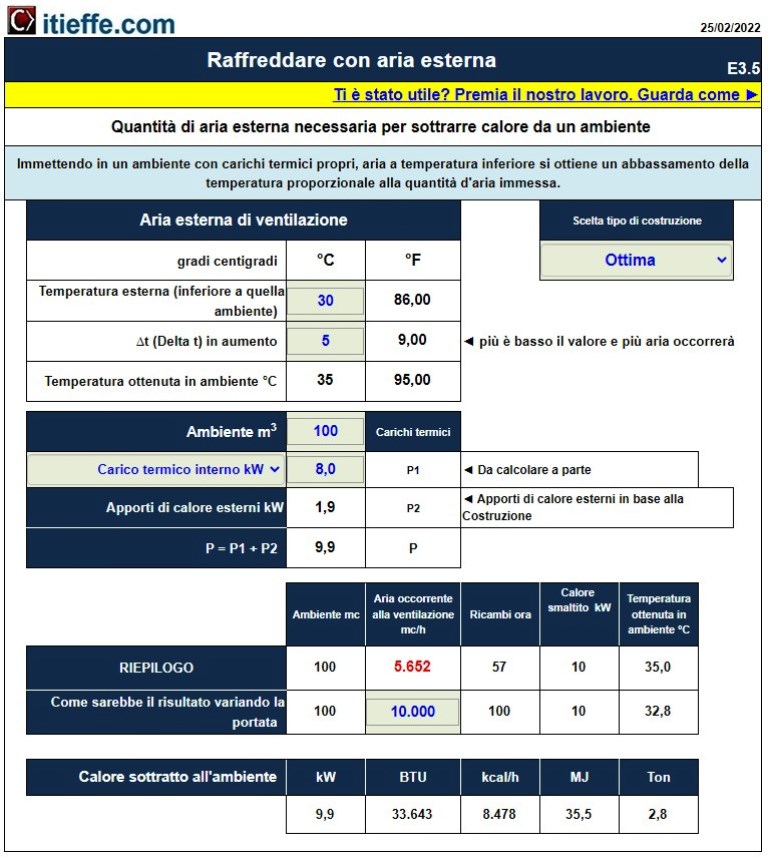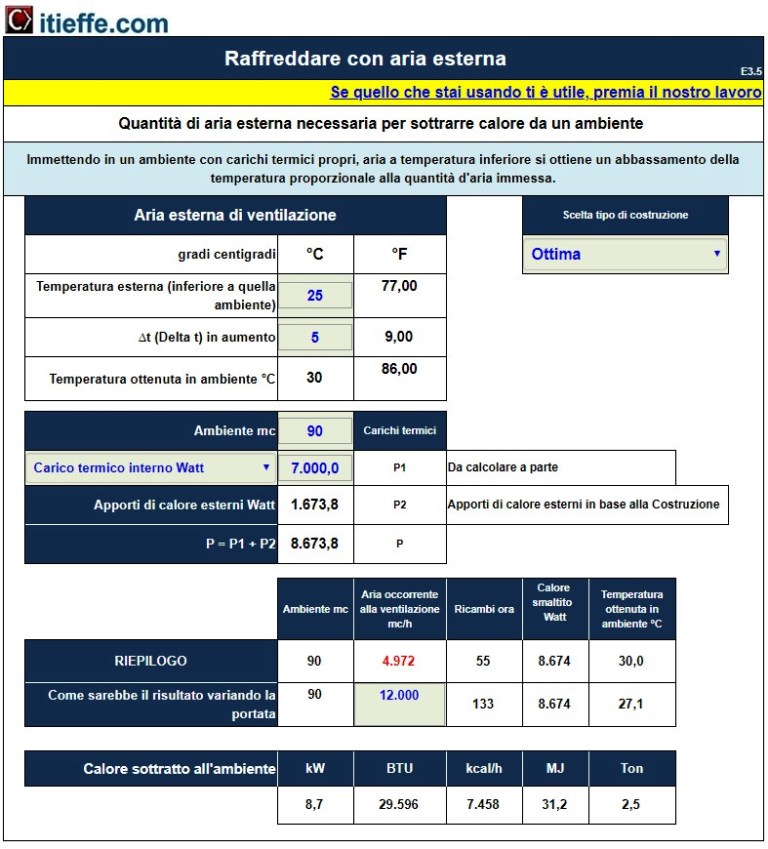Cool with fresh air

Quantity of external air at a lower temperature, necessary to remove heat from an environment - Data entry also in kW, BTU and KJ in addition to kcal/h
The Fresh Air Cooling program offers a number of benefits that may be of great interest to those involved in the design and optimization of fresh air based cooling systems.
Some of the key benefits include:
- Energy efficiency: Using outside air for cooling can reduce reliance on traditional cooling systems, such as air conditioners, significantly reducing overall building or facility energy consumption.
- Environmental sustainability: Reducing the use of mechanical cooling systems can contribute to lower greenhouse gas emissions and lower environmental impact, thus supporting environmental sustainability.
- Reduced operating costs: Using outside air to cool can translate into lower long-term operating costs, as it requires less energy than traditional cooling systems.
- Improved comfort: Systems that incorporate outside air cooling can help create more comfortable and natural indoor environments, while avoiding the health-damaging overcooling often associated with conventional air conditioning systems.
- Less system load: Using outside air for cooling can reduce the heat load on air conditioning systems, extending their life and reducing the need for maintenance.
- Design flexibility: The program can assist in designing customized solutions to make best use of local climatic characteristics and building architecture.
- Response to climatic fluctuations: Outdoor air-based cooling systems can be more flexible in adapting to seasonal and daily climate variations, improving indoor temperature management.
- Reduction of the urban heat island effect: the adoption of cooling solutions with external air can help mitigate the heat island effect in urban areas, improving air quality and the comfort of inhabitants.
- Technological innovation: the program can provide advanced and analytical tools to optimize fresh air cooling processes, thus encouraging innovation in the thermal engineering sector.
- Compatibility with renewable energy: outdoor air can be exploited in synergy with solar energy or other renewable sources to further optimize the efficiency of the cooling systems.
Synthesizing
In summary, the program created and offered free of charge by Itieffe, "Cooling with outside air" offers significant advantages in terms of efficiency, sustainability and comfort, contributing to a more intelligent and ecological design of cooling systems.
Cool with fresh air
How many times have we asked ourselves: "but with all this fresh air we have outside, why should we use air conditioners to cool an environment?".
This simple program indicates the quantity of external air, at a very specific temperature, to be introduced into an environment without having to resort to refrigeration systems with much more expensive consumption.
These are the bases of free cooling, also known as Free cooling.
Quantity of external air at a lower temperature, necessary to remove heat from an environment.
Data entry in: W, kW, BTU, MJ, kcal / h.
Complete with detailed instructions.
Instructions
By circulating in an environment with high thermal loads its own air at a lower temperature, a decrease in the internal temperature is obtained proportional to the quantity of air introduced.
How to proceed:
1 - For the calculation (during the day), enter the value of the outside air temperature that will be conveyed to the environment (take it from shaded areas).
2 - Make a choice of the type of construction (excellent - good - sufficient - poor - bad).
3 - Enter the value of the variation of the expected temperature increasing ∆t (Delta t) of the external one. For example: if the outdoor temperature is 30 ° C and the chosen ∆t is 5 ° C, the temperature that will be reached in the room will be 35 ° C.
4 - Enter the cubature of the room.
5 - Enter the heat load of the environment by calculating the heat sources to be subtracted (it can be entered in Watts - kW - kcal / h - BTU - kJ)
6 - The summary shows the calculated results where there will be the flow of air to be introduced into the environment to have a maximum temperature of 35 ° C.
7 - the next row shows how the same data would be if a different ventilation air value was entered.
8 - the last line shows the various loads removed from the environment in the most common units of measurement.
The elaborate is useful for those who want to lower the temperature in an environment during the day and in the hot months, without resorting to much more expensive air conditioning systems and with higher operating costs.
Obviously at night and in the cool months, with the lowering of the temperatures, everything is even more performing (it is recommended to insert a thermostat to control the system).
It is possible to use this system in combination with an air cooler comprising an air treatment unit and using it all in free cooling, obtaining significant energy savings in cool seasons.
Here's an example:
in the environment we have a sensitive thermal load (consider 7.000 Watts) which brings the temperature around 40 ° C (fictitious), assuming that it is an environment (optimal structure) containing refrigerators (the maximum expected operating temperature is around 30 ° C ), with the outside temperature below the expected room temperature, it can be cooled.
With external air of 25 ° C and an air exchange of 4.972 m³ / h (see drawing below), the expected result is obtained.
It should be noted that if 12.000 m³ / h (arbitrary) were introduced into the room, the temperature in the room would drop to 27 ° C.

Other free programs of the same kind offered by itieffe ▼
- Air conditioning
- Air ducts
- Ventilation systems
- Autonomous air conditioners
- Psychrometric charts
- Air conditioning tables
- Air quality
- Conditioning diagrams & drawings
Cool with fresh air
The program below is free to use.
To access the reserved version (see below), full page and without advertising, you must be registered.
You can register now by clicking HERE
